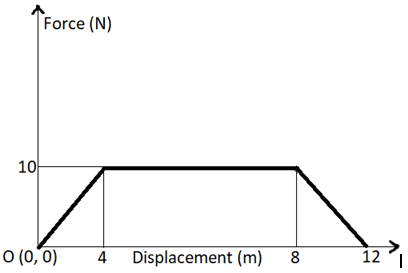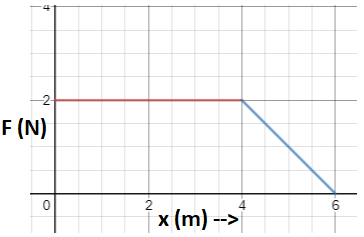This set of Class 11 Physics Chapter 6 Multiple Choice Questions & Answers (MCQs) focuses on “Work Done by a Variable Force”.
1. A particle of mass 0.1 kg is subjected to a force which varies with distance as shown in the figure. What is the work done?

a) 20 J
b) 40 J
c) 60 J
d) 80 J
View Answer
Explanation: The work done (W) is given by;
W = Force x Displacement
The area enclosed by the curves in the graph shown gives the work done;
Enclosed area = [(1/2) x 4 x 10] + (4 x 10) + [(1/2) x 4 x 10]
= 80 Nm
= 80 J.
2. The length of a smooth inclined plane of 30-degree inclination is 5 m. The work done in moving a 10 kg mass from the bottom of the inclined plane to the top is _____ Joules. (Assume g = 10m/s2)
a) 250
b) 1000
c) 1250
d) 500
View Answer
Explanation: Length (l) = 5 m
Height = Displacement = 5 x sin30
= 5 x (1/2)
= 2.5
Force on object = m x g
= 10 X 10
= 100 N
Work = Force x Displacement
= 100 x 2.5
= 250 Joules.
3. A rope has a uniform mass density of 0.4 kg/m. The rope is 10 m long and is lowered into a 10 m deep pit. The bottom part of the rope just touches the bottom of the pit. What is the work done to pull the rope out of the well completely? (Assume g = 10m/s2)
a) 200 J
b) 400 J
c) 2000 J
d) 4000 J
View Answer
Explanation: Mass density (p) = 0.4 kg/m
Length (l) = 10 m
Force = f(x)
= m(x)*g
= 0.4x*g
= 4x
Displacement (d) = 10 m
Work = \(\int_{0}^{l}\)f(x)dx
= \(\int_{0}^{10}\)4xdx
= 200 J.
4. A bucket filled with water weighing 20 kg is raised from a well of depth 20 m. If the linear density of the rope is 0.2 kg/m, the work done is _____ (Assume g = 10m/s2)
a) 4000 J
b) 4040 J
c) 4400 J
d) 4800 J
View Answer
Explanation: Mass density (p) = 0.2 kg/m
Length (l) = 20 m
Force = f(x)
= m(x)*g
= 0.2x*g
= 2x
Displacement (d) = 20 m
Work = \(\int_{0}^{l}\)f(x)dx+ (20*g*20)
= \(\int_{0}^{20}\)2xdx + 4000
= 4400 J.
5. A force F = (5i – 3j +2k) N moves a particle from r1 = (2i + 7j + 4k) m to r2 = (5i + 2j + 8k) m. What is the work done by the force?
a) 18 J
b) 28 J
c) 38 J
d) 48 J
View Answer
Explanation: Displacement (d) = r2 – r1
= (3i – 5j + 4k) m
Work = Force . Displacement; [Dot product of vectors]
= (5i – 3j +2k) .(3i – 5j + 4k)
= 38 J.
6. A person of mass 50 kg carrying a load of 20 kg walks up a staircase. The width and height of each step are 0.25 m and 0.2 m respectively. What is the work done by the man in walking 20 steps?(Assume g = 10m/s2)
a) 800 J
b) 1600 J
c) 2000 J
d) 2800 J
View Answer
Explanation: Total mass (m) = 50 + 20 = 70 kg
Vertical displacement = 0.2 x 20 = 4m
Horizontal displacement = 0.25 x 20 = 5m
Displacement = (5i + 4j) m
Force = m x acceleration
= 70 x (0i + 10j)
= (700j) N
Work = Force .Displacement
= (0i + 700j) . (5i + 4j)
= 2800 J.
7. A chain of length 4 m is kept on a table. 2 m of the chain hangs freely from the table’s edge. The mass of the whole chain is 8 kg. What is the work done to pull the whole chain onto the table? (Assume g = 10m/s2)
a) 20 J
b) 40 J
c) 60 J
d) 80 J
View Answer
Explanation: Mass per length of chain (p) = 8/4 = 2 kg/m
Mass of ‘x’ m of length = 2x kg
Force = \(\int_{0}^{2}\)(2x * g)dx
= \(\int_{0}^{2}\)20xdx
= 40 J.
8. The area under the force (F) versus displacement (x) graph gives work.
a) True
b) False
View Answer
Explanation: The area under this graph would be \(\int_{x1}^{x2}\)F * dx, which is work. Here x1 & x2 are two positions on the x-axis. Hence the statement is true.
9. An object of mass 1kg is subjected to a variable force in x-direction. The force function is F = x2 N. What is the work done in moving the object from x = 2 to 5?
a) 40
b) 39
c) 38
d) 69
View Answer
Explanation: The work is given by formula W = \(\int_{x1}^{x2}\)F * dx. So, W = \(\int_{2}^{5}\)x2 * dx = (53-23)/3 = 39 J.
10. A particle is acted upon by a force in x direction which varies as shown in the graph. What is the work done on the particle?

a) 100 J
b) 10 J
c) 200 J
d) 150 J
View Answer
Explanation: The work done is the area under the force versus displacement graph. The area can be calculated as area of trapezium i.e. 0.5*(sum of parallel sides)*height = 0.5*(6+4)*2 = 10.
11. What is the SI unit of variable force?
a) Newtons
b) Joules
c) Ampere
d) Mole
View Answer
Explanation: The SI unit of force is Newtons. While Joules, Ampere, and Mole are SI units of energy, current and amount of substance.
12. A spring is stretched by a length x, then the potential energy stored in it changes by 0.5*k*x2, where k is the spring constant.
a) True
b) False
View Answer
Explanation: The potential energy of a stretched spring is given by 0.5*k*x2 where x is the elongation in the spring.
13. A force of 600 N elongates a spring from its natural length of 18 cm to a length of 20 cm. What is the work done?
a) 116J
b) 114J
c) 118J
d) 120J
View Answer
Explanation: The force on a spring stretched by x meters is given by F = k*x where k is the spring constant. So, 600 = k*(2/100). Now k = 3*104, and hence F = 30000*x. W = \(\int_{x1}^{x2}\)F * dx = \(\int_{0.18}^{0.2}\)30000 * x * dx = 114 J.
14. Which of the following is not a variable force?
a) F = x
b) F = y2
c) F = 2
d) F = 2*t
View Answer
Explanation: F = x, F = x2 varies with x and y co-ordinate respectively. F = 2*t varies with time but F = 2 is always constant.
15. Which of the following is not a conservative force?
a) Gravitational force
b) Spring force
c) Friction force
d) Magnetic force
View Answer
Explanation: Friction force causes energy losses in form of heat so it is a non-conservative force while gravitational, spring and magnetic forces are all conservative.
16. A force F = x + 1 N acts on a particle in x direction. What is the work done from x = 2m to 5 m?
a) 10.5 J
b) 14.5 J
c) 13.5 J
d) 0.5 J
View Answer
Explanation: Work done is given by W = \(\int_{x1}^{x2}\)F * dx. So, W = \(\int_{2}^{5}\)(x + 1) * dx = [(52/2 + 5) – (22/2+2)] = 13.5.
17. What is the value of spring constant if force of 200 N is acting on it and the spring is compressed by 2m?
a) 100 kgs-2
b) 100 kgs-1
c) 100 kg2s2
d) 100 Kgs
View Answer
Explanation: Force on a elongated/compressed spring is given by F = k*x where k is spring constant and x is elongation/compression. So, 200 = k*2 which gives k = 100 kgs-2.
Sanfoundry Global Education & Learning Series – Physics – Class 11.
To practice all chapters and topics of class 11 Physics, here is complete set of 1000+ Multiple Choice Questions and Answers.
If you find a mistake in question / option / answer, kindly take a screenshot and email to [email protected]
- Practice Class 11 - Biology MCQs
- Check Class 11 - Physics Books
- Practice Class 12 - Physics MCQs
- Practice Class 11 - Chemistry MCQs
- Practice Class 11 - Mathematics MCQs
